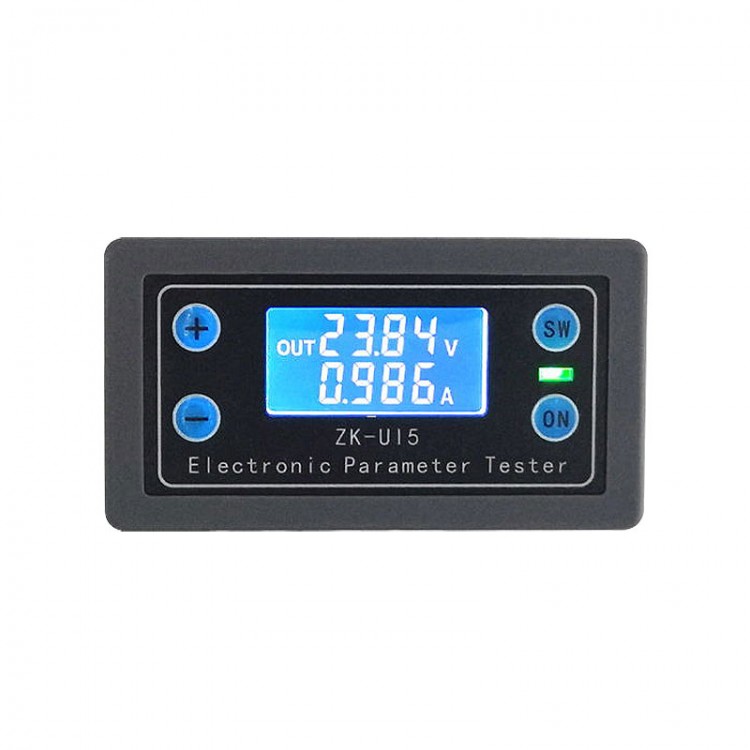
| Quantity | 3+ units | 10+ units | 30+ units | 50+ units | More |
|---|---|---|---|---|---|
| Price /Unit | $8.42 | $8.25 | $7.99 | $7.65 | Contact US |
 FUZRR ES3000P Multifunctional Micro-controller 3-Wire Ground Resistance Tester 0-20Kohms High Precision Earth Resistance Tester
$275.47
FUZRR ES3000P Multifunctional Micro-controller 3-Wire Ground Resistance Tester 0-20Kohms High Precision Earth Resistance Tester
$275.47
 150W Multifunctional Bluetooth Battery Capacity Tester CC/CR/CP/CV/PT/BRT Intelligent DC Programmable Electronic Load
$59.21
150W Multifunctional Bluetooth Battery Capacity Tester CC/CR/CP/CV/PT/BRT Intelligent DC Programmable Electronic Load
$59.21
 FUZRR ES3090E 220A Loop Resistance Tester Micro-ohmmeter for High Voltage Switch Contact Resistance Measurement
$1,466.23
FUZRR ES3090E 220A Loop Resistance Tester Micro-ohmmeter for High Voltage Switch Contact Resistance Measurement
$1,466.23
Voltmeter Ammeter Power Capacity Time Low-Voltage Over-Voltage Protections Charge Discharge Control
Features:
- Measurement circuit draws power from power input port and does not require an additional power cord.
- LCD screen can display voltage, current, power, discharge mAH, discharge time, operating temperature and other information.
- Complete protection mechanism with various protections such as under-voltage protection, over-voltage protection, over-current protection, over-power protection, over-temperature protection, overtime protection and over-capacity protection.
- Overcharge and over-discharge control of battery can be achieved by setting appropriate under-voltage protection and over-voltage protection thresholds.
- By setting appropriate time-out protection and over-capacity protection thresholds, battery can be charged and discharged regularly.
Note: Battery and other items in the pictures are not included, for demonstration purpose only.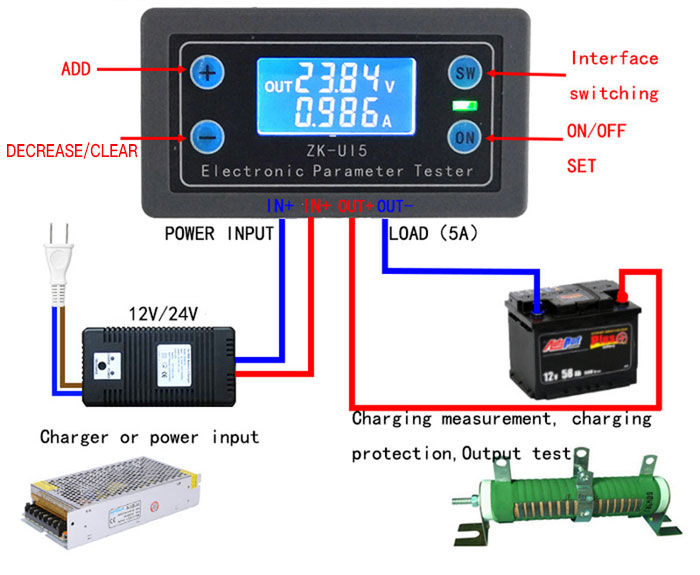
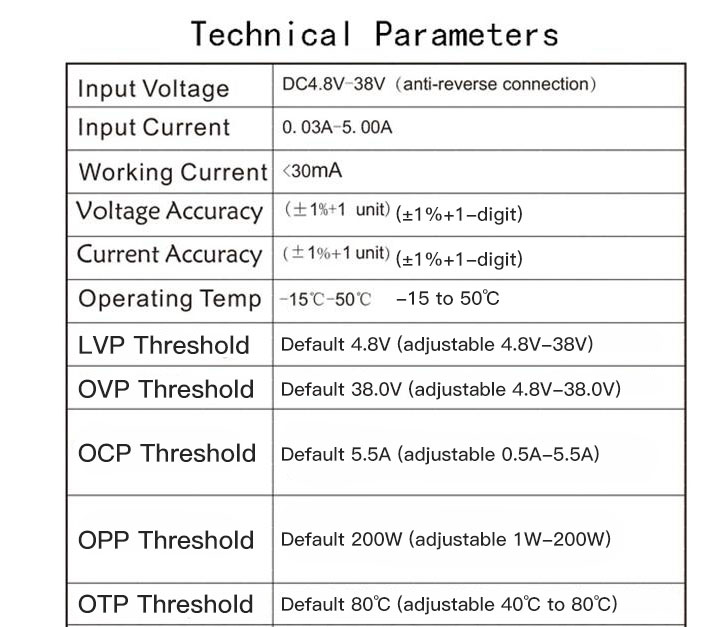
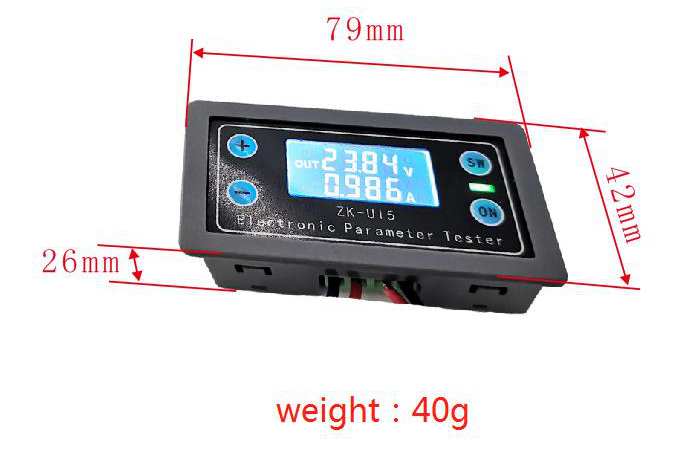
Functions:
1.LCD Display:
In normal mode, LCD displays input voltage and temperature in the first line. And displays real-time current, power, capacity and discharge time.
In protection mode, LCD screen displays protection code.
In setting mode, LCD screen displays various setting parameter codes and parameter thresholds.
2.Sound & Light Alarms:
When voltage and ammeter output is on, RUN indicator is always on and buzzer does not sound. When output is off, RUN indicator is off and buzzer does not sound. After entering protection mode, buzzer alarms and RUN indicator flashes.
3.Automatic charge capacity, discharge capacity, and time statistics. As long as output is turned on (RUN indicator is always on), statistics are started. When output is turned off (RUN indicator is off), statistics are stopped. Statistics data will be cleared during power failure. When capacity and time interface is displayed, press and hold button - to clear the corresponding data. Before starting statistics, please clear the former statistics. The maximum discharge capacity (OAH) and maximum discharge time (OHP) can be set to on or off in setting mode (default state: off). You can set thresholds after turning on. When threshold is exceeded, output is automatically turned off, and the buzzer alarms, thereby realizing unattended battery charging and discharging.
4.By setting appropriate over-voltage protection threshold and under-voltage protection threshold, you can achieve over-charge and over-discharge control of batteries. For detailed operations, please refer to the following product application examples.
5.Perfect software and hardware protection mechanism, and software protection threshold can be adjusted. After software protection works, output will be turned off.
Hardware protection:
Module input port is protected against reverse connection.
Software protections:
OVP: over-voltage protection (Default 38V, can be set by yourself. After over-voltage protection, RUN indicator flashes and LCD interface displays OVP. In battery charging, setting an appropriate threshold can effectively prevent battery from being overcharged);
OCP: over-current protection (Default 5.5A, can be set by yourself. After over-current protection, RUN indicator flashes and LCD displays OCP);
OPP: Over-power protection (Default 200W, which can be set by yourself. After over-power protection, RUN indicator flashes and LCD flashes to show OPP);
OTP: Over-temperature protection (Default value is 80 ℃, which can be set by yourself. After over-temperature protection, RUN indicator flashes and LCD displays OTP);
LVP: Low-voltage protection (Default 4.8V, can be set by yourself. After under-voltage protection, RUN indicator flashes and LCD displays LVP. In applications such as battery discharge testing, setting an appropriate LVP can effectively prevent battery from over-discharging to avoid damage)
6.Voltage and ammeter output is turned on by default.
7.All settable parameters can be stored after power-off.
Operations via Buttons: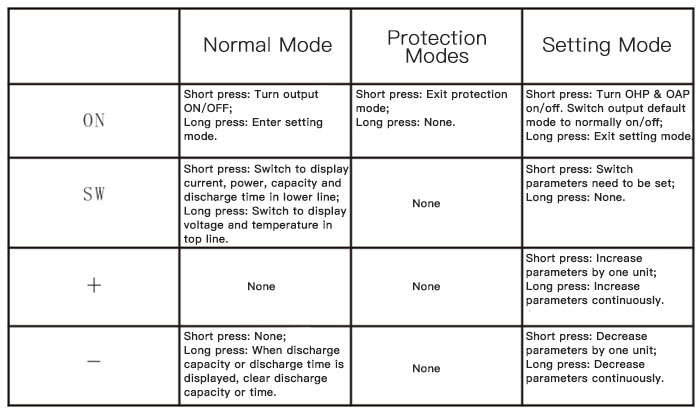
Product Interfaces:
1.Normal Mode Interface:
Attention: Short press SW button to switch displaying current, power, discharge capacity and discharge time in lower line. Long press SW to switch displaying voltage and temperature display in top line. OUT is displayed when output is on. OUT is not displayed when output is off.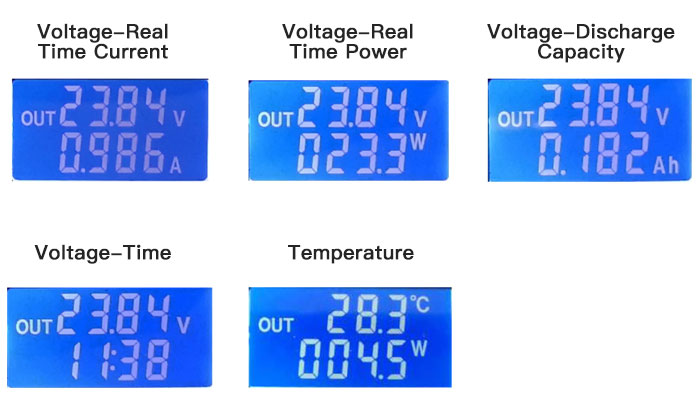
2.Protection Mode Interfaces:
Attention: When the parameter measured by the voltage and ammeter exceeds set parameter threshold, it enters protection mode, displays protection code, output is turned off, LED flashes, and buzzer alarms. In protection mode, short press ON button to exit protection mode.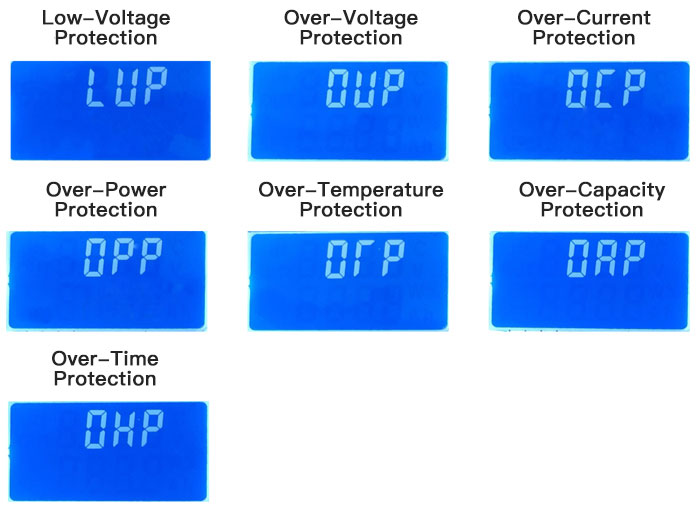
3.Setting Mode Interfaces:
Attention: In normal mode, long press button ON to enter setting mode. In setting mode, long press button ON to enter normal mode.
In setting interface, short press SW button to switch parameters to be set. Short press button + or - to adjust parameters. When over-time or overcapacity interface is displayed, press button ON shortly to select to turn on or off overtime protection or overcapacity protection. Their default state is off.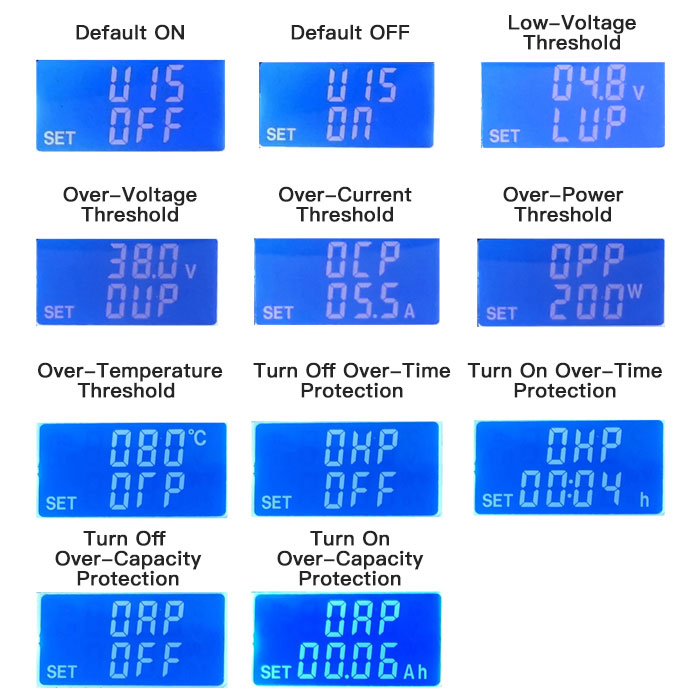
Product Applications:
1. For ordinary voltage, current and power meters, just connect them in series.
2. Battery charging applications are as follows: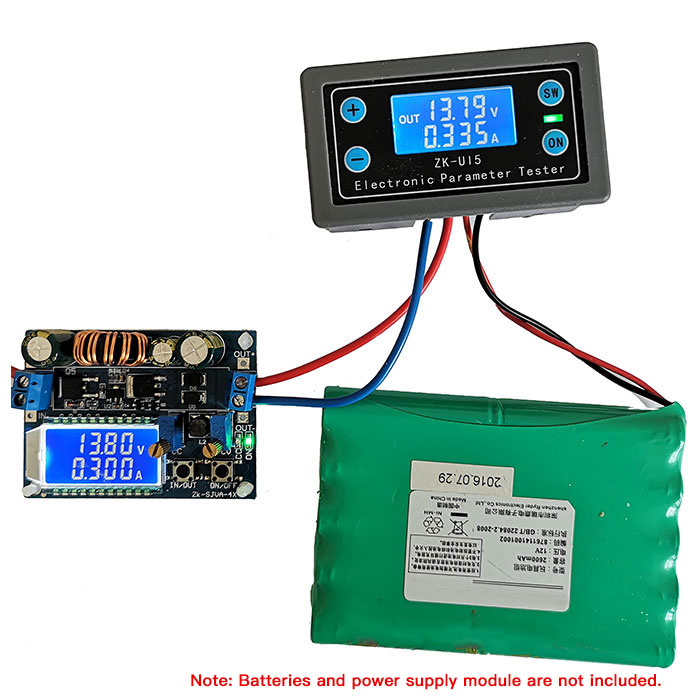
Using Steps:
1.Connect power module and battery according to the figure above, and check the wiring.
2.Power on and enter normal interface as shown above.
3.Press and hold ON key to enter setting interface. SET will be displayed in the lower left corner of LCD screen.
4. Short press SW key to switch parameters to be set. Short press + or-to increase or decrease parameters by 1. Long press button + or - to make parameters continuously increase or decrease. In battery charging applications, LVP needs to be adjusted below the minimum battery voltage, the minimum is 4.8V. OVP is adjusted to the highest voltage that a battery allows to be fully charged (this voltage needs to refer to the parameters in your battery manual). Generally, the maximum charging voltage of a 12V lithium battery is 14V. Generally, the maximum charging voltage of a 24V lithium battery is 28V.
5.Press and hold ON key to exit setting mode.
6.Short press ON key, indicator light is always on, output is turned on, and battery starts to charge.
7.If a battery voltage rises to the value set by OVP, output is turned off, the battery stops charging, LCD screen displays OVP, indicator light flashes, and the buzzer alarms.
8. If regular charging or constant capacity charging is required, you can set OHP (timing) or OAP (constant capacity) parameters in setting mode. Setting steps: In the setting interface, short press SW key to switch to OHP or OAH interface. Short press ON key to turn on timer or fixed capacity function, and LCD interface will change from OFF to digital. Press + or-to adjust parameters. After setting parameters, press and hold ON key to exit setting interface. When time or capacity reaches the set value, output is turned off to stop charging, LCD screen displays OHP or OAP code, indicator light flashes, and the buzzer alarms.
3. For Battery Discharge: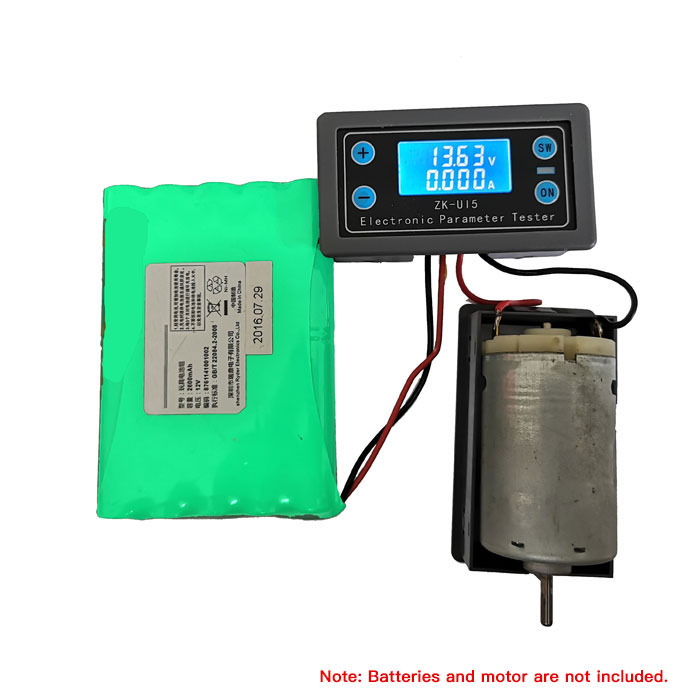
1. Connect battery and load according to the figure above, and check whether the wiring is correct.
2. The voltage and ammeter enters normal interface.
3. Press and hold ON key to enter setting interface, and the lower left corner of LCD screen displays SET.
4. Short press SW key to switch parameters to be set. Short press button + or - to increase or decrease parameters by 1. Press and hold + or - to increase or decrease parameters continuously. In battery discharge applications, OVP needs to be adjusted above the maximum battery voltage, up to 38V. Adjust LVP to the lowest voltage allowed by your battery (this voltage needs to refer to the parameters in your battery manual). Generally, the minimum discharge voltage of a 12V lithium battery is 9.2V. The minimum discharge voltage of a 24V lithium battery is 18.5V.
5. Press and hold ON key to exit setting mode.
6. Short press ON key, indicator light is always on, output is on, and battery begins to discharge.
7. If the battery voltage drops to the value set by LVP, output is turned off, the battery stops discharging, LCD screen displays LVP, indicator light flashes, and the buzzer alarms.
8. If regular discharge or constant capacity discharge is required, you can set OHP (timing) or OAP (constant capacity) parameters in the setting mode. Setting steps: In setting interface, short press SW key to switch to OHP or OAH interface. Short press ON key to turn on timer or fixed capacity function, and LCD interface will change from OFF to digital. Press + or - to adjust parameters. After setting parameters, press and hold ON key to exit setting interface. When the time or capacity reaches the set value, output turns off and stops discharging, LCD screen displays OHP or OAP code, indicator light flashes, and the buzzer alarms.
Package Included:
- 1 x Voltmeter Ammeter